Most Antarctic life clings to the edge, where beaches and cliffs offer snow-free nesting places for birds and pupping places for seals.
Tony Soper, author of Antarctica: the Bradt Guide
Antarctica is one of our hot destinations for the year ahead – check out the full list of the best places to travel in 2024 here.
One of the world’s last great wildernesses, Antarctica is a region of superlatives: the coldest, windiest, driest place on earth. But a great concentration of wildlife thrives in this challenging environment, and those who brave the extreme conditions are rewarded with an unforgettable experience.
Albatrosses and whales rule the seas, penguins throng the beaches in their thousands, and seals bask in raucous company. All this plays out against an icy backdrop of awe-inspiring beauty.
For more information, check out our guide to the Antarctic
What to see and do in the Antarctic
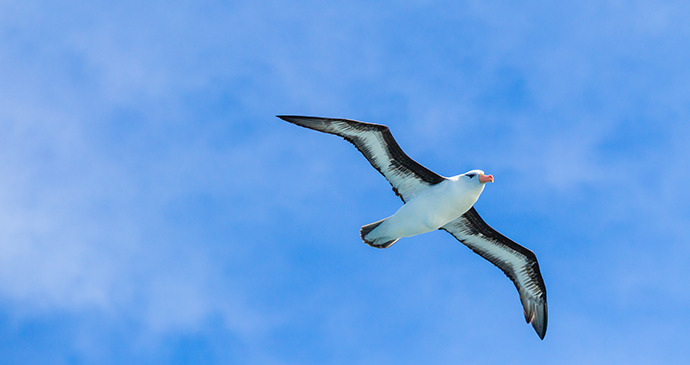
Albatrosses
The name is an English sailors’ corruption of the Portuguese alcatraz for a pelican, a bird which early explorers would have known from the Mediterranean. Albatrosses are divided into two genera, Diomedea and Phoebetria, but in common language the 14 species are crudely divided into the ‘great albatrosses’, the wandering and royal; and the ‘small albatrosses’, collectively better known to seafarers as mollymawks, from the Dutch mal, foolish, and mok, gull. Another term for them is ‘gooney’, from the English dialect word for simpleton. These pejorative and richly undeserved epithets were the result partly of seeing albatrosses ashore, out of theirelement, appearing clumsy, and partly because of their endearing but ill-advised innocence in standing quietly while being bludgeoned by a club and pickedup for the pot.
In the late 18th and 19th centuries albatrosses were much persecuted both for their meat and their plumage, and were also taken in significant numberson hook and line by sailors who made pouches out of their webbed feet, feather rugs from their skins and pipe stems from their bones. Albatrosses have stout bodies with large heads on long necks, mostly short tails and strikingly long and narrow wings (over 3.6m (12ft) in the wanderer). They have short legs, placed well back, but the most eye-catching feature is the massive hooked bill, covered with a number of horny plates. Adult great albatrosses are mainly white, while the twelve smaller species (mollymawks) have variable quantities of black on the back as well as on the wings. Most are inhabitants of the southern oceans, mainly between 30° and 60°S, but one is based on the equatorial Galápagos Islands, ranging the Humboldt current area. Three are confined to the North Pacific, effectively isolated from their southern cousins by the windless region of the doldrums. None breed on the Antarctic continent.
Albatrosses spend most of their lives in flight, gliding the waves and circling the major wind systems. They are highly accomplished dynamic soarers, seemingly motionless yet totally in control, but they rely on a constant supply of wind and are highly inefficient in flapping flight. In the occasional calm they are forced to sit it out on the surface and wait.
Their food is mainly squid, taken by surface-seizing when they settle on the water, floating high with plenty of freeboard, wings often raised to keep them dry. They will also examine floating weed in the hope of finding fish eggs and they will follow ships for galley waste. They are slow to mature, mollymawks breeding in their sixth or seventh year, great albatrosses in their ninth. Giving evidence of their southern origins, even the North Pacific species breed at the time of the southern summer, October to April. They all breed colonially, on remote oceanic islands. Mating for life, they court with dances which may seem somewhat ungainly to us, bowing and scraping, bill rubbing and wing stretching. The nest is a scrape on the ground or a mud mound lined with a few feathers or grasses. The single chick is fed by regurgitation of stomach oil. The process is long drawn out: from egg-laying to fledging takes a year in the case of the great albatrosses, and as a consequence they breed only in alternate years. Mortality is very high in the first year, but those which survive enjoy long lives, many reaching ages well over 50.
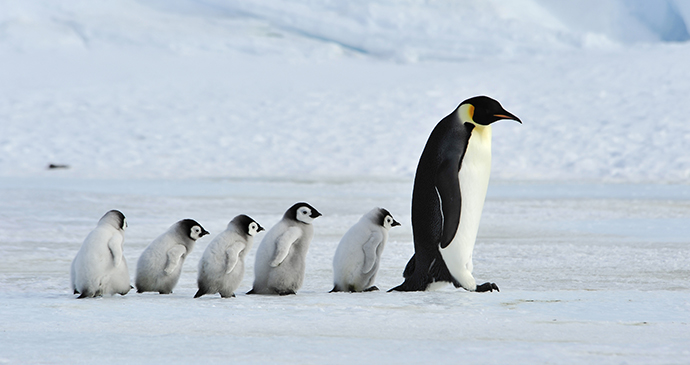
Penguins
Penguins have a long history. Millions of years ago, in the Tertiary period, there were at least 25 species in 18 genera. In the Miocene there was a species 1.5m (5ft) tall, weighing well over 90kg (200lb). Today we have 17, some would say 18, species. Contrary to general opinion, few of them live in the Antarctic though they are widespread and virtually confined to the Southern Hemisphere (the exception being the equatorial Galápagos penguin).
Early explorers thought penguins were fish and classified them accordingly. In fact, as birds, they are superbly designed for their job, flying underwater with great skill. Their compact, streamlined bodies have a deep keel for a breastbone and massive paddle muscles. Their feathers are reduced in size and stiffened, with a fluffy aftershaft at the base. This down creates an insulating layer of air over a thick layer of blubber and skin. Their heads retract to create a perfect hydrodynamic shape. Effectively their bodies are packed in blubber, with a string vest and a windproof outer parka. Their wings are reduced to paddles, and the bones flattened, with the wrist and elbow joints fused, so that although the wing can’t be folded, it acts as a powerful propulsion unit. The legs are set well back on the body so that the feet act as control surfaces in the water. Some walk, some progress by jumps, some by tobogganing over ice and snow. Some can climb steep cliff faces, some leap like salmon in order to land on ice floes. On land they walk upright with a seaman’s rolling gait. In the water they travel fast by ‘porpoising’ at the surface or diving in pursuit of squids, shrimps or fish.
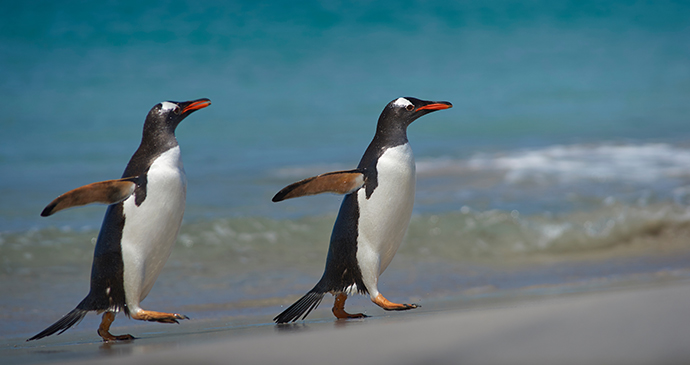
They are highly sociable birds, both at sea and ashore, breeding in colonies which can involve hundreds of thousands of pairs. Those few which breed in tropical or temperate habitats do so underground to avoid the sun. The invisible barrier of warm tropical water denies them access north of the equator. (It is true that the Galápagos penguin breeds just a few miles into the Northern Hemisphere, but only because the Humboldt current swings around the islands bringing cold water from the Antarctic, forcing the equatorial warm water northwards at that point. Only nit-pickers will deny that the Galápagos penguin is biologically southern.) While king penguins are enjoying a healthy population, most Antarctic and sub-Antarctic species have been decreasing in recent years.
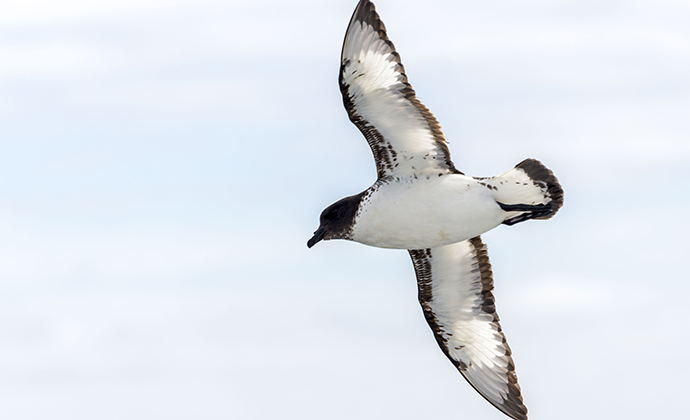
Petrels
From the mighty albatross to the diminutive storm-petrel, the petrels, or ‘tubenoses’, includemany species in a wide-ranging group of families. They are characteristically marked by deeply grooved and hooked bills. Their long nostrils indicate a highly developed sense of smell, which is unusual among birds; indeed, they themselves exhibit a musky odour. In feeding, they store fish-oil in their stomachs, using it to regurgitate for their young or to spit at intruders in a highly effective defence. Superb and distinctive in flight, they are at a grave disadvantage ashore, where they waddle about in a clumsy manner. Only the giant petrels walk strongly on land, exploiting this unusual petrel facility to take terrestrial prey, especially carrion.
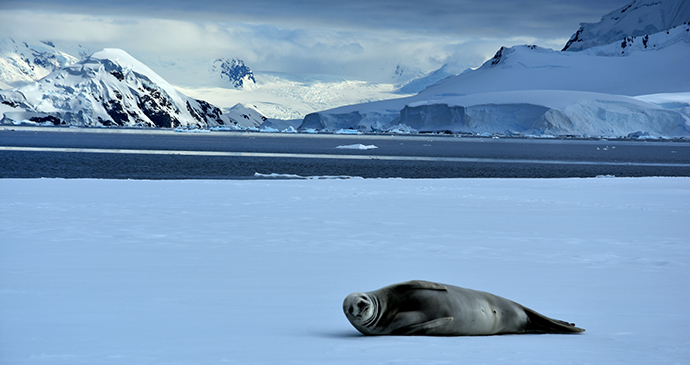
Seals
There are two main divisions – Superfamilies – in the Pinnipeds. First the Otariidae which includes fur seals, sea lions and walruses. In the Antarctic, the only representative of these ‘eared’ seals is the fur seal Arctocephalus gazella. They have pointed snouts, a very thick underfur and hind flippers which can be turned forwards and used to great effect in almost galloping over land.
The other major grouping is of the Phocidae, the ‘true’ seals which have no protruding external ear, cannot run or raise themselves on fore flippers, cannot swivel their hind flippers and must clumsily haul or hump themselves on land in caterpillar fashion. Seals are well adapted to aquatic life in polar regions, cushioned and insulated from the cold air as effectively as from cold water with either a thick coat of blubber or a dense pelage.
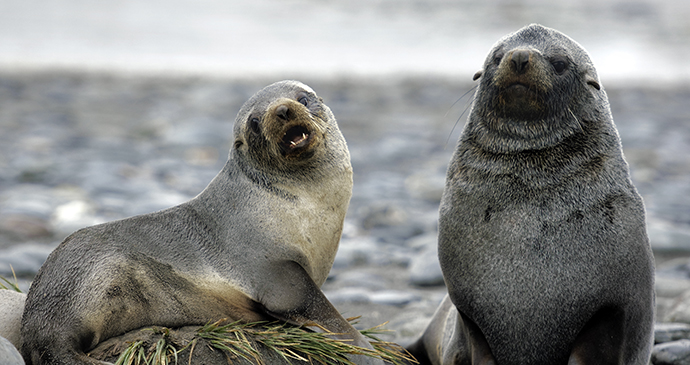
They have torpedo-shaped bodies superbly designed for fast underwater travel. Their nostrils may be closed and sealed by muscular contraction as they enter the water. They exhale before diving to reduce the amount of air in their lungs and derive the necessary oxygen from their well-supplied blood systems. Their heart-rate slows, their metabolism is reduced. On surfacing it is several minutes before their heart-beat returns to its surface rate.
Seals must come ashore to breed, but some species are as comfortably able to pup on the fast-ice as on the sub-Antarctic or continental beaches. Males and pregnant females gather annually at the breeding place, where copulation takes place soon after the pups are born. Implantation is delayed for three months so that, although the gestation period is nine months, the annual cycle is maintained.
The four truly Antarctic species are the leopard, the crabeater, the Weddell and the Ross seal. The Antarctic fur seal and the southern elephant seal, or sea elephant, the largest of all the seals, are abundant elsewhere in the sub-Antarctic islands and southern South America, but are at the southern end of their range in the Antarctic Peninsula.
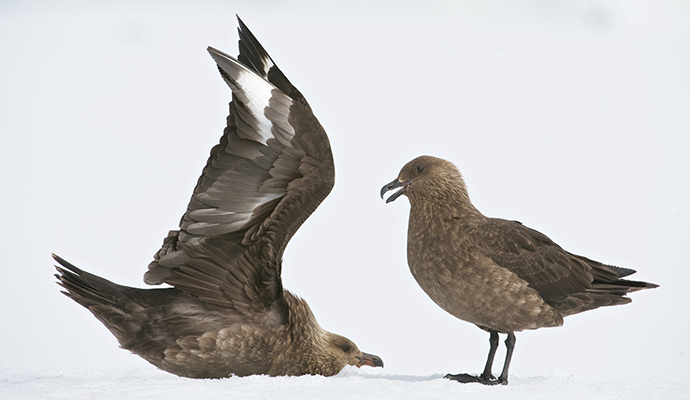
Skuas
The name ‘skua’ comes from the Old Norse skufr or skúgvur and is presumably an onomatapoeic rendering of their chase-calls in flight. Skuas look superficially like immature gulls, but they are heavier, more robust and menacing in mien, as befits birds of prey. They have conspicuous white patches at the base of the primaries. Theirs is a piratical nature and they have hawk-like beaks to serve it. Half a dozen species in two genera breed in the high latitudes of both hemispheres. Much learned discussion revolves around the question of how many species are present in the deep south, since distinct populations exist on various island groups. In Antarctica, the main contenders are the south polar skua and the brown skua, the southern version of the great skua. While they are generally accepted as distinct species it is often not in the least easy to separate them in the field, when their distribution overlaps, as in the peninsula, and where they occasionally hybridise as Catharacta maccormicki x lonnbergi.
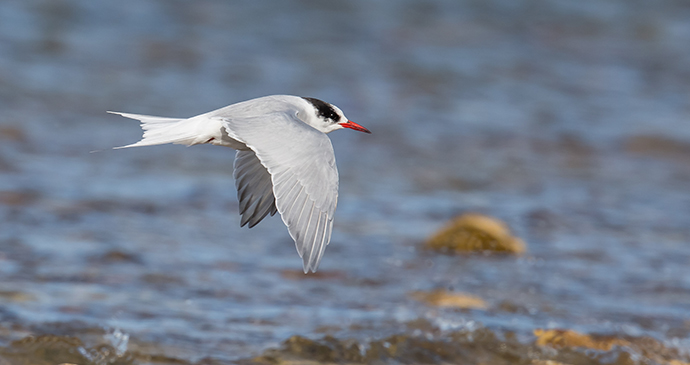
Terns
There are over forty species of tern, from the Arctic to the Antarctic. Most are birds of the coast, some are oceanic. They are smaller, more graceful and more streamlined than the gulls which they superficially resemble, but they have narrower, more pointed wings and slender, sharp-pointed bills. Many have deeply forked tails, earning them the sailor’s name of sea-swallow. They are short in the legs with small webbed feet; buoyant on the sea yet rarely in it, for they swim poorly. They often enjoy a rest on a piece of driftwood or raft of seaweed.
Terns tend to have white bodies with grey backs and wings, very often a black cap and sometimes a jaunty crest. Their bills and feet range in colour from black to blood-red or yellow. Exceptionally aerial, they roost at night but are in the air for most of the day, outside the breeding season. They can live for long periods on the wing. They fly with steady purposeful wingbeats, never soaring, tending to look down, their beaks pointing to the water. In searching for fish they may hover, then plunge head first for small fish at the surface – splash, snatch and up again.
Typically, terns nest in close-packed colonies, some very populous indeed. The stimulus and noise of company leads them to synchronise their egg-laying, with resulting advantages in terms of safety – the safety of numbers which confuses predators like rats, skuas and gulls. Even so, there is high mortality, which accounts for the average clutch of three or four eggs.
The nest is often little more than a shallow depression, a hollow on a sandy or shingle beach, usually on an island. The chicks are fed on whole small fish, such as sand-eels, which may be longer than the chick itself, so that while the head end is being digested the tail hangs out for all to see. Breeding success relies on the supply of suitable fish. The chicks are heavily dependent on their parents until long after they have fledged, but if they are lucky they may live to the ripe old age of 30.
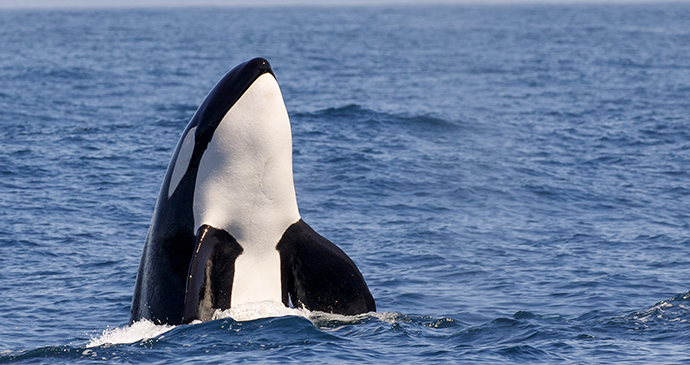
Whales and dolphins
Whales, dolphins and porpoises are members of the order Cetacea. They are totally adapted to a life at sea but, as mammals, they must surface to breathe. Modifications to the standard mammal design involve a hairless fish-shape encased in a thick layer of insulating blubber, the nose on top of the head, forefeet becoming paddles, effective loss of hind feet and the tail becoming a horizontal fluke. Supported by water, they are free to grow to a great size and weight. They are divided into two broad sub-orders, the Odontoceti (toothed whales) and the Mysticeti (whalebone or baleen whales). Sperm and killer whales (which are large dolphins) and the other dolphins belong to the toothed division, and are beasts of prey, whereas the whalebone whales feed by filtering plankton through a series of baleen plates which hang from the position normally occupied by the upper teeth.
Working in murky water at great depths, toothed whales find their prey by echo-location, using ultrasonic pulses which are inaudible to human ears. They communicate within their group with trills, whistles, grunts and groans which are perfectly audible above water.
Baleen whales have a profoundly different method of feeding. In relatively shallow water, they plough through the concentrations of plankton (possibly finding them by taste), gulping great quantities of water, expelling it through filter-plates of whalebone by contracting the ventral grooves of the throat and pressing the large tongue against the roof of the mouth, then swallowing the catch of uncountable numbers of small shrimps and larval fish. Not needing the agility and manoeuvrability of the hunting whales, they enjoy the advantages of greater size: the blue whale is the largest animal ever to live on earth.
Related articles
Nothing found.